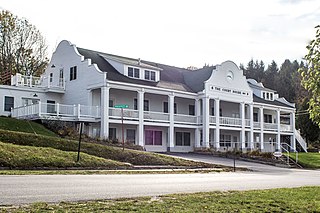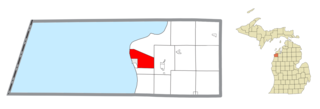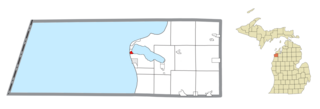
Grand Traverse County is a county located in the U.S. state of Michigan. As of the 2020 census, the population was 95,238, making it the largest county in Northern Michigan. Its county seat is Traverse City. The county is part of the Traverse City micropolitan area, which also includes neighboring Benzie, Kalkaska, and Leelanau counties.

Benzie County is a county in the U.S. state of Michigan. As of the 2020 census, the population was 17,970. The county seat is Beulah. The county was initially set off in 1863 and organized in 1869. At 321 square miles (830 km2), Benzie County is the smallest of the 83 counties in Michigan in terms of land area.

Benzonia Township is a civil township of Benzie County in the U.S. state of Michigan. As of the 2020 census, the township population was 1,870.

Blaine Township is a civil township of Benzie County in the U.S. state of Michigan. As of the 2020 census, the township population was 484. It is located in the southwest portion of the county. There are no significant population centers in the township; the nearest towns are Arcadia to the south, Benzonia to the northeast, and Elberta to the northwest. M-22 is the township's main thoroughfare.

Colfax Township is a civil township of Benzie County in the U.S. state of Michigan. The population was 504 at the 2020 census. Colfax Township contains half of the village of Thompsonville, and the entire community of Nessen City

Crystal Lake Township is a civil township of Benzie County in the U.S. state of Michigan. The population was 1,065 at the 2020 census.

Elberta is a village in Benzie County in the U.S. state of Michigan. The population was 329 at the 2020 census. Located in Gilmore Township, Elberta overlooks Lake Michigan and lies across Betsie Lake from Frankfort. Elberta is part of Northern Michigan.

Gilmore Township is a civil township of Benzie County in the U.S. state of Michigan. The population was 813 at the 2020 census. The L-shaped township contains the village of Elberta and is bordered on the north by the city of Frankfort. The narrow township is located between Crystal Lake Township to the north and Blaine Township to the south, as well as a short boundary with Benzonia Township to the east.

Inland Township is a civil township of Benzie County in the U.S. state of Michigan. The population was 2,386 at the 2020 census. The township is located in the east of the county, and shares a border with Grand Traverse County. The Platte River flows through the north of the township.

Thompsonville is a village in Benzie County in the U.S. state of Michigan. The village had a population of 451 at the 2020 census, up from 441 at the 2010 census. The village lies immediately north of the Manistee County line, and is divided between Colfax and Weldon townships.

Grant Township is a civil township of Grand Traverse County in the U.S. state of Michigan. As of the 2020 census, the township population was 1,212, a slight increase from 1,066 at the 2010 census. Grant Township is part of the Traverse City micropolitan area.

Green Lake Township is a civil township of Grand Traverse County in the U.S. state of Michigan. The population was 6,703 at the 2020 census, an increase from 5,784 at the 2010 census. The township is named after Green Lake, one of two large lakes in the township.
Springdale Township is a civil township of Manistee County in the U.S. state of Michigan. The population was 849 at the 2020 census.

Keego Harbor is a city in Oakland County in the U.S. state of Michigan. A northern suburb of Detroit, Keego Harbor is located roughly 27 miles (43.5 km) from downtown Detroit, and about 3 miles (4.8 km) southwest of Pontiac. As of the 2010 census, the city had a population of 2,970. With a land area of 0.50 square miles (1.29 km2), Keego Harbor is the third-smallest city by land area in the state of Michigan, after Petersburg and Clarkston.

Ferrysburg is a city in Ottawa County in the U.S. state of Michigan. The population was 2,892 at the 2010 census.

Interlochen is an unincorporated community and census-designated place (CDP) in Grand Traverse County in the U.S. state of Michigan. At the 2020 census, the population was 694, up from 583 at the 2010 census. The community is located within Green Lake Township, and is home to a post office operating with ZIP Code 49643.
The Traverse City Metropolitan Statistical Area, as defined by the United States Census Bureau, is an area consisting of four counties in Northern Michigan, anchored by the city of Traverse City. This area is commonly referred to as Northwestern Michigan or the Traverse Bay Area, after Grand Traverse Bay. The area consists of the counties of Benzie, Grand Traverse, Kalkaska, and Leelanau.

The Betsie River is a 54.0-mile-long (86.9 km) river in the U.S. state of Michigan. The river is located in the northwestern Lower Peninsula of the state, flowing into Lake Michigan at Frankfort. The river's course is mostly within Benzie County,, although the river rises in western Grand Traverse County and flows briefly through northern Manistee County.

Pilgrim is an unincorporated community and census-designated place (CDP) in Benzie County in the U.S. state of Michigan. As of the 2020 census, the CDP had a permanent population of 44. Pilgrim is located within Crystal Lake Township.
Duck Lake is a large lake in the Lower Peninsula of the U.S. state of Michigan. Located within Green Lake Township, Grand Traverse County, Duck Lake is one of two lakes the forms the isthmus of Interlochen, the other being Green Lake. Duck Lake and Green Lake form part of the headwaters of the Betsie River, which flows west from Green Lake through Benzie County to Lake Michigan at Frankfort and Elberta. Duck Lake is about 9.5 miles (15.3 km) southwest of Traverse City.






















